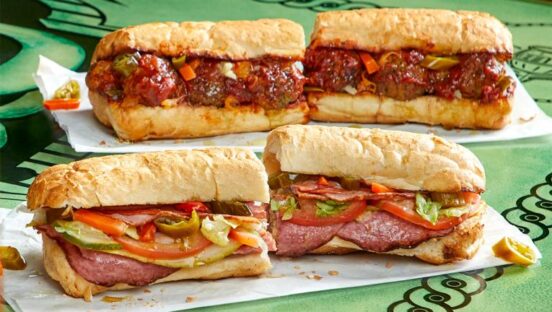Potbelly CEO Bob Wright said the chain is in the early innings of its digital transformation—that makes the brand’s current streak all the more impressive.
The second quarter marked the fast casual’s seventh consecutive period of record digital sales. Online/app accounted for 38 percent of total sales, which is a 170-basis-point increase from last year. That growth is primarily through channels owned by Potbelly, which bodes well for its long-term goal of 16 percent shop-level margins.
The digital surge was fueled by enhanced app and web interfaces, efforts to increase acquisition and activation of the Perks Loyalty Program, and engagement through targeted digital promotions and advertisements. For instance, in Q2 Potbelly announced the return of its Underground Menu—which is only available via the app—and reintroduced the Clubby, featuring roasted turkey breast, hickory smoked ham, crispy Applewood smoked bacon, and Provolone cheese dressed with lettuce, tomato, and buttermilk ranch. Despite being available only through the app, it quickly became the No. 1 sandwich within the first few days.
Potbelly doesn’t provide detailed metrics on the penetration or member acquisition rates of its loyalty program, but Wright did say he’s “incredibly pleased” with its contribution to the digital business in Q2. The rewards program is filled with customers that are more frequent, come with a higher average check, and are very easy to activate via promotions.
“They’re becoming more and more affiliated with and have a higher affinity for the brand and they’d like the way that they’re brought into that sort of friendly ecosystem,” Wright said during the chain’s Q2 earnings call. “We think that’s very favorable for us over time and we also think we’ve got a lot of room to run with growing Perks because clearly once they’re in our channels, we get all that data. We get to speak to them directly, we get more of a one-on-one relationship with them and we have different nurturing channels depending on their behavior.”
READ MORE:
Growing Potbelly Ignites Refranchising Strategy
Inside Potbelly’s Comeback, from Potential to Powerhouse
Potbelly’s same-store sales rose 12.9 percent in Q2, driven mainly by expansion in traffic and market share. April, May, and June saw comps growth of at least 10 percent, and all real estate types—suburban, central business district, and airport locations—grew in the high single digits. Wright said the brand’s growth in traffic has outpaced the fast-casual segment week-on-week and month-on-month for a while.
In addition to its marketing efforts and loyalty program, Potbelly attributes its fast-casual outperformance to Potbelly’s Digital Kitchen, a recently rolled-out platform that helps a restaurant’s ability to sort orders, present them to employees, and coordinate processes. The technology is meant to increase speed of service, throughput, accuracy, and food quality. The Digital Kitchen is still being launched in existing shops; it will be standard in all new franchise locations.
“We also continue to be encouraged by the benefits we’re seeing from Potbelly Digital Kitchen or PDK, which are clearly showcased through the ongoing growth of our digital business and our ability to handle the incremental throughput, particularly during peak periods,” Wright said. “Moreover, the improvements in the customer experience are equally important, evidenced by orders ready on time, accuracy, and food quality scores.”
The Shop-level profit margin was 14 percent in the second quarter, up from 11.4 percent in Q2 2022. Restaurants earned $25,950 in average weekly sales, which is $1.34 million in annualized AUV.
All of the improved financial figures are translating to increased development activity. Potbelly has signed commitments for 106 restaurants under its Franchise Growth Acceleration initiative. That includes founder Bryant Kyle, who signed a 27-unit deal—12 refranchised shops and 15 to be developed in Maryland. Development agreements have also been signed in North Carolina, South Carolina, Virginia, Florida, Tennessee, New York, Maryland, Illinois, and South Dakota.
Potbelly finished Q2 with 427 stores systemwide (372 corporate locations and 55 franchises). That’s a net loss of 13 restaurants year-over-year. The long-term goal is to reach 2,000 outlets in the U.S. over the next decade. On its way there, the company will refranchise 25 percent of its company footprint and ramp up franchise unit growth to at least 10 percent annually. As a further investment, Potbelly in June hired Lynette McKee as senior vice president of franchising. The new executive, with past stops at Dunkin’, Burger King, and Checkers & Rally’s, is responsible for all aspects of franchisee market planning, franchise recruitment, and sales.
Potbelly opened 10 or fewer restaurants in 2019, 2020, 2021, and 2022, and the brand will be somewhere in that ballpark for 2023 as well. But in 2024, the unit expansion is expected to surpass 40 stores.
“We are excited to celebrate the number of shop commitments that we have since we started our franchise growth acceleration initiative and at 106 we feel like the pace is in our favor,” Wright said. “And as with development in any brand, it’s all about building momentum and so what we’re looking forward to is building on the momentum we have and developing more of that as we finish this year and all through next year.”
Wright also noted that while nontraditional locales present a “big opportunity” for Potbelly, typical streetside restaurants are being prioritized in the coming years.
“I’d like to be clear on the balance there,” Wright said. “Our emphasis is on [shop development agreements] and [shop development area agreements] with multiunit franchisees that will build out a certain territory. It’s the best way to penetrate the market. It provides the most predictable pattern of growth for us.”
In Q3, Potbelly projects average weekly sales per store will be between $25,000 and $25,500, same-store sales between 7 and 9 percent, and shop-level margins between 12 percent and 14 percent.
For the full year, the chain expects record-high AUVs, comps in the high single digits to low double digits, and shop-level margins in the low teens.








